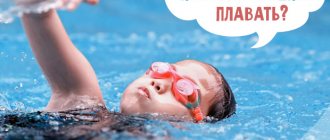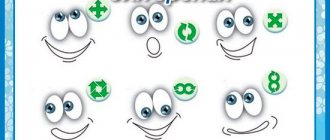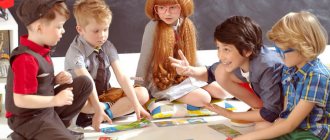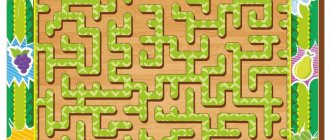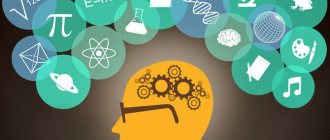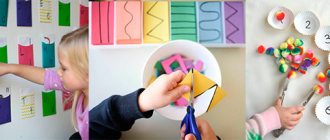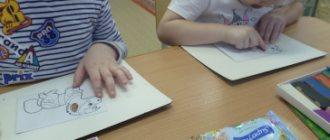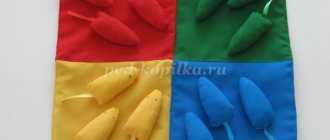What is mnemonics
The concept is associated with a system that helps to assimilate large amounts of information. These are exercises that help evoke associations and remember. Associations can be kinesthetic (tactile), visual (visible), auditory (auditory).
How to remember a date from history?
Imagine that this is the day and month of “your acquaintance” with a historical character. Or the day when “you visited” the site of a historical event.
Everyone can associate differently. The task of parents is to teach the child to find the association on his own based on examples and remember it. And then reproduce it in memory.
Where and who will use mnemonics?
- For children - to remember information in school and kindergarten. Learning poetry with this technique is a pleasure for both children and parents.
- For students - to effectively pass the session and tests. It’s easy to repeat and remember the year’s material in a week! The main thing is to use techniques.
- For adults - at work, in making presentations, in planning things, making shopping lists and much more.
No talent or special abilities are needed to teach mnemonics. We need systematic, disciplined training. Have information you need to remember? Remember one of our exercises and put it into practice with your children.
Rules for conducting classes
The process of working and learning with children should be comfortable and beneficial.
- You need to start with simple tasks. First, you can look at cards with single images.
- You should not immediately overload your preschooler; he will quickly get tired and will not absorb the information. You can show no more than two mnemonic tables per day.
- All images of didactic material must be bright and colorful. Children quickly remember colorful images. The grass is green, the carrot is orange, the pine cone is brown, the sea is blue.
- It is worth changing the topic of the lesson every time, otherwise the child will lose interest. Today we are learning poetry. Tomorrow - a fairy tale, wild animals, etc.
- It is important that classes take place only in a playful way.
How do preschoolers learn mnemonics?
Teaching the system to preschool children often begins at 4-5 years of age with the simplest techniques.
- A mnemonic square is a card that shows one image, one word or a short phrase. Used from 3-4 years.
- A mnemonic track is a series of mnemonic squares. Used from 5-6 years.
- A mnemonic table is a series of mnemonic tracks. Used from 7 years old.
Exercises for preschoolers
- Invite the kids to study, describe and remember what is shown in the pictures. At first, children try to retell simple stories using visual associations, and later they compose stories from several illustrations. So, from the pictures you can quickly remember how to wash your hands and in what order to get dressed.
- The game “Remember the Shape” is suitable for children 4 - 5 years old. Using toothpicks or matches, make several shapes in sequence. When the child looks at them, ask him to turn away. Remove one of the shapes and ask them to guess which shape you removed from the sequence. Over time, make the shapes more complex. You can experiment with toys, numbers, any objects.
Such mnemonic techniques help children diversify their vocabulary, develop speech, construct common sentences in answers, and communicate more confidently and freely with each other.
If you want your child to become successful in life, we also advise you to teach him to manage his emotions - read how to do this here.
There are rules that are easy to follow when working:
- Increase the time gradually . On the first day - 5 minutes, then - 10-15. So gradually increase your exercise time to 40 minutes a day in several approaches.
- The younger the child, the simpler the exercises. We will offer you a group of mnemonic exercises for beginners “from simple to complex.”
- Use colorfulness . Bright colors and emotional involvement of parents will not let you get bored. And they will make the lesson super interesting!
- Don't force it. This will only discourage you from studying.
Using mnemonics methods in teaching preschool children
Bibliographic description:
Volkova, V. E. Using mnemonics methods in teaching preschool children / V. E. Volkova. — Text: immediate // Current tasks of pedagogy: materials of the IX International. scientific conf. (Moscow, June 2022). - Moscow: Buki-Vedi, 2022. - pp. 18-20. — URL: https://moluch.ru/conf/ped/archive/279/14285/ (access date: 02/05/2022).
The use of mnemonic methods in the development of preschool children is becoming increasingly relevant. The relevance of mnemonics for preschoolers is due to the fact that at this age figurative memory predominates in children, memorization often occurs involuntarily, and its productivity increases with visual reinforcement. Mnemonics helps speed up the memorization process in preschoolers, develop figurative, logical, associative thinking (including the ability to systematize, analyze, isolate parts, combine into pairs, groups, the whole), imagination, attention. In addition, the use of mnemonic techniques enriches children's vocabulary and promotes the formation of coherent speech. Children develop the prerequisites for self-education, the ability to conduct introspection, children become more liberated and independent [4].
Mnemonics methods can be taught either in the form of an independent lesson, or its elements can be included in various types of classes and even in various types of children’s activities.
An analysis of publications on the use of mnemonics in kindergarten showed that the emphasis in working with preschoolers is on the development of memory and speech.
The most accessible and widely used by preschool teachers is the “cropping” method - the use of mnemonic tables, collages, drawings, diagrams, sketches, sketches.
A mnemonic table is a diagram, a structure in which various information can be included.
To begin with, children are introduced to mnemonic squares - clear images that represent one word, phrase, its characteristics or a simple sentence. Then the task becomes more complicated, a mnemonic track is demonstrated - this is a square of four pictures, from which you can compose a short story in 2-3 sentences. And finally, the most complex structure is mnemonic tables. They are images of the main links, including schematic ones, from which you can remember and reproduce an entire story or even a poem [1].
The use of mnemonic tables in working with children allows them to better perceive and process visual information, recode, store and reproduce it in accordance with the assigned educational tasks.
In preschool education, developmental and educational mnemonic tables are used [8].
Developmental mnemonic tables are aimed at developing basic mental processes: memory, attention, imaginative and logical thinking. The children are shown a table and the encoded information is deciphered. Logical connections, quantitative and qualitative characteristics are established. Then you are given time to memorize the table. The table is removed and the children reproduce it graphically from memory.
Educational mnemonic tables can be used in work in any educational field, they allow you to more productively remember material on lexical topics, facilitate learning storytelling, literacy (memorizing letters, rules), memorizing poems, proverbs, contribute to the correction of violations of sound pronunciation, work on differentiating sounds, the formation of elementary mathematical ideas, familiarize preschoolers with nature, contribute to the education of cultural and hygienic skills, the formation of ideas about dangerous situations and methods of behavior in them, the development of cognitive and research activities, familiarization with the surrounding social world, the formation of ideas about types of art, the implementation of independent creative activities, and the improvement of skills in visual, constructive and modeling activities, the formation of initial ideas about a healthy lifestyle, the improvement of skills in basic types of movements, physical exercises, activity in independent motor activity, etc.
Working with educational mnemonic tables is somewhat different, since they contain educational information, usually unfamiliar to children, so the main role belongs to the teacher, especially if this is the first mnemonic table in a certain direction [7].
Initially, the tables are compiled by teachers and parents, then the child can be involved in this process, the main thing when compiling tables is that the pictures are connected with each other, because children, in order to memorize the tables, must make up a story or connect them in meaning, or classify them.
Collages are educational aids that solve the problems of developing photographic memory in preschoolers, expanding vocabulary, and imaginative perception; the ability to speak and tell stories that fulfill the task of teaching children [6].
A collage is thick paper (cardboard, flannelgraph) of various formats (depending on the purpose), on which various pictures, letters, geometric shapes, and numbers are pasted, superimposed or drawn.
The apparent chaos of pictures superimposed on the format is the essence of the collage.
Children are explained that a collage is similar to a “salad”, when they take many different products and combine them together to get a tasty dish. Therefore, the first and main task of a collage is to connect, that is, to connect all the pictures with each other. Thus, the plot method of memorization is being developed.
Examples of using collages in the speech development of children: exercise “Reading a letter from a picture” - children receive a letter - a diagram, which they must decipher; game “Traffic Light” - children must determine the place of a certain sound in a word and lay out the diagram cards in order, this will be a hint for children in reproducing a chain of words [6].
Sketching words makes it possible to develop children's imagination, thinking, and creative abilities, promotes memorization of words, and makes them think. Thanks to sketches, children remember poems faster; using sketches, you can offer to guess a poem already familiar to children. A very effective technique is sketching at the initial stage of learning in the game “Chain of Words”, where children make sketches for themselves, depicting a word they hear. Thus, children get a chain of drawings from which they can easily remember all the words. This game can be made more complicated by asking you to close your clues and remember what was drawn, or you can also remember and reproduce the sketches from memory on another piece of paper.
The method of associative chains or the “nonsense” method is that children make up a story - “nonsense” from the proposed words or a set of pictures; they seem to be fooling around and in such a game they quickly remember the chain of words. For example, the words: bird, ball, leaf, kitten, etc. With these words we come up with the story “The bird is playing with a ball, the ball is fanning itself with a leaf, the leaf bit the kitten, etc.” At first glance, this seems complete nonsense, and children associate every word with some action, location, etc. You can play games like “What’s missing” and “Confusion” [5].
Having analyzed the experience of using mnemonics in working with preschoolers, we found that for the development of coherent speech, the most effective would be to use the “cropping” method (mnemonics, collages, drawings, diagrams, sketches, sketches). This method in preschool pedagogy is called differently: sensory-graphic diagrams (V.K. Vorobyova), subject-schematic models (T.A. Tkachenko), square blocks (V.P. Glukhov), collage (T.V. . Bolsheva), scheme for compiling a story (L. N. Efimenkova), scheme-model (L. E. Belousova).
A special place in working with children is occupied by didactic material in the form of mnemonic tables, collages and diagrams, which significantly makes it easier for children to master coherent speech; In addition, the presence of a visual plan makes stories (fairy tales) clear, coherent and consistent.
Working with mnemonic tables is built from simple to complex.
T.V. Bolshova [3] recommends starting work with the simplest mnemonic squares, then sequentially moving on to mnemonic tracks, and later to mnemonic tables. She offers ready-made mnemonic tables for composing stories, and L. E. Belousova [2] believes that for better memorization, children themselves should come up with and sketch symbols in the proposed diagram. T. B. Polyanskaya notes that for children of primary and middle preschool age it is necessary to give colored mnemonic tables (fox - red tail, Christmas tree - green triangle), and for older preschoolers - black and white [5]. The authors propose the following technology for working with mnemonic tables:
- examining the table and analyzing the symbols depicted on it;
‒ recoding information (converting symbols into images);
‒ retelling of the work by the teacher based on symbols (the initial stage of working with mnemonic tables), by children together with the teacher or by the children themselves.
T. B. Polyanskaya notes the need to work with children to learn to read symbols. She points to a lot of preliminary work for GCD on speech development with the help of mnemonic tables: preparation of additional cognitive material that expands the horizons of children: discussion with children of what they saw on excursions, observations of natural phenomena, works of art; preparation of equipment and handouts; the teacher’s choice of techniques that may interest children in the lesson. In the GCD, the author includes a discussion on the topic (“What do you know about this?”), outdoor games, word games, listening to music, reading poetry, sayings, folk signs, etc. The main part of the GCD is the compilation of descriptive stories using mnemonic tables and diagrams - tables (from the preparatory group). To consolidate the acquired knowledge, together with the children, the teacher prepares albums on the covered topic with children's stories and drawings [5].
Teachers of preschool institutions widely use mnemonics when organizing other types of activities for preschoolers: to enrich the vocabulary of preschoolers, when teaching how to write stories, when retelling works of art, when guessing and making riddles, when memorizing poetry, when working with fairy tales, when introducing preschoolers to nature , in cognitive cycle classes. For example, the topic “Animals”: appearance (body parts); place of residence (cow barn, kennel, pigsty, etc. (for domestic animals) or den, lair, burrow, etc. (for wild animals); what it eats; what is the name of the cub; what benefits does it bring to humans (to describe only domestic animals); in which fairy tales or cartoons does this animal appear?
Thus, the use of mnemonic techniques in working with preschoolers is a popular area, allowing not only to speed up the process of memorizing information, but also to develop mental processes and visually present the material being studied. The “crocking” method (mnemonic tables, collages, diagrams) helps to successfully cope with the task of developing coherent speech in preschoolers, which is confirmed by the results of the work of practicing teachers who describe their experience in this direction.
Literature:
- Barsukova E. L. Automation of sounds using mnemonic tracks // Speech therapist. — 2009.- No. 5. — From 18–23.
- Belousova L. E. Learn to retell? It's simple! - St. Petersburg: Litera, 2009–65 p.
- Bolshova T.V. Learning from a fairy tale. Development of thinking of preschoolers with the help of mnemonics: Educational and methodological manual. 2nd ed. corr. - St. Petersburg: Detstvo-Press, 2005. - 96 p.
- Guryeva N. A. Exercises on mnemonics. - St. Petersburg: Firefly, 2000.
- Polyanskaya T. B. Using the method of mnemonics in teaching storytelling to preschool children - M.: Detstvo-press, 2010–64p.
- Svatkova L. A. Experience in using mnemonics in the development of preschool children. — Access mode: https://dohcolonoc.ru/cons/3794-ispolzovanie-metoda-mnemotekhniki-pri-oznakomlenii-doshkolnikov-s-mirom-professij.html
- Spynu V.V. Teaching the compilation of descriptive stories for preschoolers with special needs based on the use of mnemonic tables // Young scientist. - 2013. - No. 11. - P. 654–657.
- Tkachenko T. A. Compilation of descriptive stories using reference diagrams Method. manual, picture kit. — M.: Knigolyub, 2014
Key terms
(automatically generated)
: child, collage, work, coherent speech, preschooler, game, story, word, writing stories, diagram.
Teaching mnemonics to schoolchildren
If you have a schoolchild or teenager, we advise you to contact a teacher who will select exercises that suit your child’s personality type. For self-study, we offer you the following exercises.
No. 1. Composing acrostics
If you need to commit a series of words or numbers to memory, try forming a phrase from the first letters. Remember how to remember the colors of the rainbow? "Every Hunter Wants to Know Where the Pheasant Sits." The principle is the same in this exercise.
No. 2. Rhyming
The technique suggests putting complex rules, lists of words, numbers into short poems. The more delirious the quatrain, the faster the lines are ingrained into memory. Rhyming is probably familiar to many from geometry lessons, explanations of complex concepts in verse: “A bisector is a rat that runs around the corners, dividing the corner in half.”
No. 3. Story method
When it is necessary to remember a series of words or what is drawn in a picture, a story is compiled from these words. The components of the structure are connected by a single semantic chain. Watch how associative chains create stories in this video:
No. 4. Search for consonant words
This mnemonic technique for beginners makes it easy to memorize foreign words.
- Let's take a foreign word (for example, the English “House”)
- We find a consonant association in a familiar language, imagine a picture (House is similar to “Chaos” that always reigns at home.)
- We repeat 2-3 times a day for memorization (we call up the same picture in our head for associations).
No. 5. Cicero's method
Cicero memorized information by arranging it “on shelves” in an imaginary room. You can also use this method. The technique is convenient for quickly assimilation of a huge amount of data. If you master this technique with your child, you will be surprised by your ability to remember information.
Imagine a museum in your mind - a detailed room with shelves, chests of drawers, chests. This is your data “storage system”. Mentally “tie” what you need to remember (an object, a word, a number) to a specific object in your room. Imagine it vividly. To remember, just mentally “take this off the shelf.”
No. 6. Aivazovsky method
Aivazovsky, a famous artist, had an excellent photographic memory. He memorized landscapes in detail and then depicted them on paper. This mnemonic technique will develop photographic memory.
- An object, a painting or part of a landscape with a lot of detail will do. Consider. Remember it.
- Mark important details where they are located in the picture.
- Close your eyes, reproduce the image in all details.
- Open it and look at the object. Check, did you remember everything? Repeat again to remember more details.
The essence of mnemonics
Visualization uses both hemispheres of the brain, so memorization is more effective
Mnemonics is a set of methods and techniques that allow you to visualize information to facilitate perception and subsequent reproduction. That is, these are a kind of notes in pictures. You should start classes using mnemonic techniques as early as possible, since in children of preschool and primary school age the leading type of memory is visual-figurative. That is, you can repeat a poem to a toddler a hundred times, but he will still confuse words and sentences. However, by drawing a plot or presenting a mixed diagram of pictures, signs and words, the baby will quickly figure out what’s what. In addition, mnemonics help:
- remember the sequence of actions (for example, what to wear before going out);
- get used to the daily routine (by marking routine moments on the clock, you can easily teach your child to perform this or that action at the appointed time);
- understand the basics of reading (pictures or symbols can be accompanied by words, letters, which causes the child to create an associative connection between the concept and the letter image);
- increase attentiveness (diagrams and tables require concentrated consideration to fully understand certain actions);
- develop imaginative thinking (visuality helps to find connections between image and word).
Books on mnemonics for children
- “Learning from a fairy tale”, T.V. Bolshakova;
- “Supermemory for everyone”, E.E. Vasilyeva, V. Yu. Vasiliev;
- “Remember everything. Practical guide to memory development”, Arthur Dumchev;
- “Brain development. How to Read Faster, Remember Better, and Achieve Bigger Goals by Roger Sipe;
- “Einstein walks on the moon. The Science and Art of Memory,” Joua Foer;
- A. R. Luria. “A little book about a big memory”;
- How to Develop Super Memory by Dominic O'Brien.
The books describe in detail common techniques, proprietary methods, give tips on mastering and demonstrate the work with examples.
Tips for using mnemonics
- Start with the basics. Don't try to remember large amounts of data at once. Practice on single images, short lists of words, dates. Focus on the techniques that mnemonics offers for beginners: the method of stories or visualization. Increase the difficulty gradually, noticing progress at previous stages.
- For training, choose bright images; for children, always color ones. Such illustrations attract attention better, allow you to focus on details, and highlight more associative connections.
- Don't get overwhelmed. For children, 2 mnemonic tables per lesson are enough, no more than 9 squares per piece. A large amount of data causes boredom and in the form of a game.
- Make mnemonics classes varied. Change exercises, topics, memorize texts, illustrations and numbers.
- Remember that you need to exercise regularly. Perform 1-3 exercises daily, gradually limiting the time or increasing the load.
Exercises for preschoolers
Preschool age is considered a favorable period for laying the foundations of competent, clear, beautiful speech. Mnemonics for beginners (simple, fun tasks, games) will help your child’s speech develop faster. It is useful for the development of the articulatory apparatus to perform tasks using onomatopoeic words. They correct diction well - pure jokes (“If only there was smoke coming out of the chimney”), nursery rhymes, phrases containing a certain group of sounds (“Sanya’s sleigh rides on its own”).
Exercises on the pronunciation of hissing sounds can be combined thematically.
After looking at the picture “Hedgehog and Hedgehogs,” the adult offers to complete a number of tasks. The child must clearly pronounce phrases with the sounds “sh” and “zh”. “Sha-sha-sha - we walk slowly; shu-shu-shu - I’ll give the baby a raspberry; shi-shi-shi - where the kids walk.” Such exercises help you master question intonation and develop a sense of rhythm.
By isolating the sound while clearly pronouncing a word, the skill of understanding the terminology “sound” and “word” is developed. When working with children, it is necessary to emphasize the development of intonation sense, rate of speech, diction, and strength of voice. Games can help with this.
Exercises for beginners:
- "Whose voice is this ? The goal of the game is for the child to learn to recognize adult animals from young animals by the reproduced sound. For such a game, you can take figurines of a dog and a puppy, a duck and a duckling, a cat and a kitten. Alternatively, you can sculpt animals from plasticine or use cards. The plot of the game: animals come to visit the baby, they want to play with him. Children should understand the difference between how a mother cat meows and how her baby meows.
- Game "Compare the cubes" . The task is to teach the child to correlate objects with different characteristics. An adult offers to look at two cubes and tell how they differ. The kid takes one cube and says that it is big, and the second cube is small. The first cube is red and the second is white. The red cube is plastic, the white cube is made of fabric and is soft inside.
- Game “Compare two kittens” . The child is asked to look at the kittens. One of them is white and large, and the second is black and smaller. You need to say who they are. Come up with names for them so that it is clear that one kitten is black and the other is white. What is the difference.
- Game “What little animals can do . The goal of the game is to choose verbs that denote the characteristic actions of animals. An adult shows pictures of animals, and the child must say what they can do or what they say. For example, a cat loves mice. She loves to meow. The dog loves to bark and eat bones, run and jump. The cockerel crows and loves to peck grains.
- Game "Profession" . Here you will need cards that depict people of different professions (pilot, hairdresser, doctor, cook). An adult asks who heals people. The kid must answer correctly. This is how the remaining cards are played.
- The game “Wizards” helps expand vocabulary, develops long-term memory and logical thinking. You will need cards with images of individual objects - a table, an apple, a door. The adult names several words, and the child must choose those cards that will help him remember the named words. He kind of “bewitches” them into these cards. Then the baby takes the cards and with their help remembers the named words. The game is aimed at understanding the logical connections between objects.
Regular playful activities help to awaken interest in words. The exercises prepare children for further independent compilation of narratives, stories, texts, and form connected speech.

